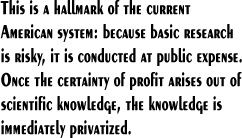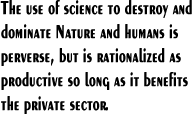1. The aims of the scientific
endeavor are straightforward:
theoretical explication of the natural world.
Science is one
expression of a basic human yearning for
understanding as old as
consciousness, seminal indications of its
existence being found
in the earliest civilizations. Intellectual
progress, however,
coalesced in Europe in the period preceding
the Enlightenment and
gave rise to a new way of studying the cosmos.
The Scientific
Revolution, as this intellectual leap has
been termed, has had
mixed effects. On the one hand, scientific
achievement has
advanced in many dimensions, giving us a
fresh appreciation of
the depth of reality in which we take part
and which we are
co-constructing. It informs us of the
immense evolutionary
distance traversed by the universe from the
primordial explosion
till today. And it raises consciousness
to a higher level of
understanding, laying the material as well
as spiritual
foundations for a much more humane and rational
social
existence. On the other hand, the technological
applications of
some scientific achievements have produced
new instruments of
violence and destruction, of control and
manipulation, which, if
not sharply diverted from their present course,
seriously
threaten to destroy humankind itself.
2. The question that arises, then, concerns
the factors that
determine which aspects of science will prevail
in a given
historical situation. Since the nature
of science itself doesn't
offer an illuminating insight, we have to
look at the system
under which science operates, analyze its
structure, and discern
its logic of functioning. Our final
goal is to assign proper
weight to various institutional factors separate
from the logic
of science itself.
3. The United States, arguably the most scientifically
advanced
state in recorded history, provides an example.
American
scientific endeavor took its present form
during World War II,
when the federal government began funding
science in the service
of war. The commercial potential of
that arrangement was
immediately recognized and seized upon by
the policy makers. The
now famous Vannevar Bush Report to Franklin
D. Roosevelt,
"Science: The Endless Frontier," established
the systemic
parameters that remain in place to this day.
It spells out the
thinking as follows: "new products, new industries,
and more jobs
require continuous additions to knowledge
of Nature and
application of that knowledge to practical
purposes" including
"new and improved weapons." The purpose
of science, under this
system, became production of knowledge of
the natural world which
can subsequently be applied towards development
of technologies
by the private sector.
4. At the same time it was also recognized
that "this essential,
new knowledge can be obtained only through
basic scientific
research." Considering that the private
sector, composed of
corporate conglomerates of concentrated economic
power, is driven
by a singular logic of profit, it cannot
be expected to fund an
enterprise whose only objective is to understand
Nature. And,
predictably, it doesn't. The burden
of funding basic research
falls to the public. Various government
agencies (National
Science Foundation, National Institutes of
Health, etc.) fund
individual academic researchers at universities,
where the
preponderance of basic research is conducted.
In the event that
knowledge demonstrates potential for a commercial
application, it
is immediately transferred from the public
to the private domain
through the patent system.
5. The private sector subsequently conducts
the final phases of
research and product development which are
least expensive and
scientifically demanding. Through tax
deductions, the public
subsidizes even this phase, so that ultimately,
the entire cost
of new product development is socialized,
while the profit is
privatized. Throughout the last half
century, this basic
structure of the political economy of American
science has
remained the same.
6. In 1980, public policy commitment to the
commercial
application of science was reaffirmed by
laws that were enacted
to improve the competitiveness of American
products on the world
market. This was done because, as one
recent report from the
National Academy of Sciences acknowledges,
"the industrialized
world had largely recovered from the effects
of World War II and
key Asian nations were devising new approaches
to industrial
production." These "increasing challenges
from competition
abroad--in markets for traditional goods
as well as a growing
list of goods based on advanced technological
capabilities--
raised new questions regarding the role the
federal government
should play in assisting US industry to develop
and use new technology for competitive purposes."
7. Answers to these questions concerning the
competitiveness of
American industrial products on the world
market can be found in
the legislation of the period. The
report continues: "The
Stevenson-Wydler Technology Innovation Act
of 1980 opened the
federal laboratories to industry, making
available not only
specialized and unique facilities, but also
opportunities for R&D
partnerships with joint funding and the use
of federally
developed technology for profit making ventures.
That same year,
Congress passed the Bayh-Dole Act, which
conferred ownership of
patent rights on universities, small businesses,
and nonprofit
organizations, thus providing a strong incentive
for commercial
development. In 1984, the National
Cooperative Research Act
amended the antitrust statutes to facilitate
cooperative R&D
between competing firms."
8. The guiding principles of policy, however,
have remained the
same since the Vannevar Bush report: the
role of the government
is to place science in the service of commerce,
to facilitate
privatization and commercialization of publicly
funded
knowledge as soon as it demonstrates profit-generating
potential. The process, called "technology
transfer," has become
institutionalized in most universities, which
now have technology
transfer offices for this purpose.
If publicly funded basic
research at a university yields potentially
profitable results,
the university is granted a patent which
is then sold to the
private sector. A recent study found
that "73% of the applicants
for US patents listed publicly funded research
as part or all
of the foundation upon which their new, potentially
patentable
findings were based."
9. The private sector thus gains a monopoly
on a given product.
The public subsequently pays monopolistic
prices despite the fact
that the research that led to product development
was publicly
funded. This is a hallmark of the current
American system:
because basic research is risky, it is conducted
at public
expense. Once the certainty of profit
arises out of scientific
knowledge, the knowledge is immediately privatized.
10. There are many concrete examples of this
system's
functioning, but, one that is particularly
egregious is the case
of HIV drugs, protease inhibitors.
They are the first example of
what has become known as rational drug design.
In the past,
pharmaceuticals were discovered either serendipitously
or by
testing large random libraries of chemicals
for potential
usefulness. However, with advances
in structural biology--again
wholly publicly funded--scientists were able
to determine the
structure of the HIV enzyme protease down
to atomic detail and to
design chemicals, specifically and rationally,
to inhibit the
action of the enzyme. The total cost
of determining the atomic
structure of protease is not easy to ascertain,
but a low
estimate lies in the range of tens of millions
of dollars when
the entirety of research that went into its
production is
considered. The research was exclusively
publicly funded. The
final phases of drug development were conducted
by pharmaceutical
companies, which subsequently developed effective
drugs and
patented them.
11. Currently there are several protease inhibitors
on the market
and an average person with HIV pays in the
vicinity of $10,000
for a year's supply. These drugs are
prohibitively
expensive for many uninsured patients, who
suffer unnecessarily
and die prematurely from the disease.
Perhaps the most
illuminating fact demonstrating the monopolistic
nature of
pricing pharmaceuticals in the United States
comes from a recent
comparative study by Medicins Sans Frontieres
(Doctors Without
Borders). They found that "the minimum
price of AIDS drugs in
the countries studied [was] on average 82%
less than the US
price." From this it is clear that,
absent public policy
constraints, the corporate sector sets prices
to extract maximum
profits from a given market with no regard
for human life and
well-being.
12. Another illustrative example is the much
discussed human
genome project. Putting its philosophical
significance aside,
let's look at the political and economic
parameters. The human
genome project comes at an advanced phase
in our understanding of
molecular biological phenomena, and it is
founded on
scientifically solid ground due to decades
of research that was
publicly funded. Most of the actual
sequencing work has been
conducted at universities and was also subsidized
by the public.
Nevertheless, the private sector has seized
upon the profit
potential of this expansion of knowledge
and has been applying
for patents on various possible applications
of our genes.
Again, putting aside the ethical implications,
the economic
factors alone are sufficiently disturbing.
The private sector
has monopolistic possession of a particular
domain of the natural
world (which also happens to reside in each
and every one of
us). It was discovered by the use of
public funds and its
exploitation is founded on a scientific understanding
also gained
by means of public resources. In accordance
with the system's
logic of functioning, the public is disposed
to pay monopolistic
prices for applications of this scientific
knowledge, as in the
past, despite its indispensable original
investment in scientific
discovery and its application.
13. These are just two examples of a systemic
logic that is
invariant to a very close approximation.
14. Even the funding priorities of the federal
government reflect
the prevailing systemic logic which is singularly
commercial.
Take the current president's latest proposal
for boosting
research funding. A 15% increase in
funding is proposed, but
only for National Institutes of Health which
funds biological
research. The reasons seem straightforward:
the most obvious
potential for profit resides in the fruitful
biological sciences,
whose discoveries can be quickly commercialized
through
technology transfer to the nascent biotech
industry. Other
domains of natural inquiry are not deemed
as important, not
surprisingly, since the primary aim of science
under the current
system is not discovery of knowledge for
appreciation of the
Beauty of Nature, but rather discovery of
foundational principles
that can be used to generate profit for the
private sector. The
scientific research agenda is driven not
by scientific curiosity
or a desire to deepen our understanding of
the cosmos but by a
singularly commercial logic of profit.
15. Another feature of the system, established
after World War
II, concerns educational policy. The
Government sets educational
policy in order to satisfy private interests:
a sufficient supply
of highly trained labor, and an educational
system which extracts
a significant amount of labor in the process
of education
itself. In accordance with systemic
logic, the public funds
education as well.
16. Science education, especially on the graduate
level, is
inextricably linked with research.
Graduate students and
post-docs carry out the bulk of the actual
research in the
sciences. They are the most productive
and the most innovative
component of the research enterprise, and
have been recognized as
such for a long time. A recent report
to Congress by the House
Committee on Science acknowledges that "students
and
post-doctoral researchers are responsible
for actually performing
much of the federally funded research done
in universities" and
that they are "a key component of the overall
research
enterprise." Thus, the report continues,
"the potential exists
for the student's graduate experience to
be dominated by the
faculty member's need to generate publishable
research
results--and not the student's own scientific
and professional
development." Furthermore, the conditions
under which graduate
students work are exploitative. They
are required to put in long
hours and give up external commitments, including
family. They
are often exposed to hazardous chemicals,
such as radioactive
materials and various organic solvents, and
complaints are
generally met with disdainful dismissal.
17. As is evident, science education is also
subordinated to the
logic governing the overall system, which
is, as we have seen,
exclusively defined by the imperatives of
profit. Since
extraction of labor is one of the key aspects
of science
education, it is not surprising that the
average length of study,
the number of PhD's granted, and the number
of graduate programs
has increased with the increase in the demand
for labor in the
biomedical sciences, as they have shown the
potential to generate
profitable knowledge. The resulting
growth in the total number
of PhD's granted causes an oversupply of
highly trained
scientists, who are unable to find faculty
posts and now spend an
average of five to seven years in post-doctoral
positions. While
they were originally meant for transient
training following
graduate study, post-doctoral positions are
now becoming a way of
life for many scientists. Generally,
the pay is barely
sufficient for subsistence, and the benefits
post-docs receive
vary greatly but are usually very modest.
Some universities
don't even consider them employees: they
are forced to pay fees
and they have few or no labor rights.
Others regard them as
employees, but give them few or no benefits.
18. The singular logic driving policy pays
little regard to the
needs of young scientists, many of whom spend
years in
post-doctoral positions with no job security
and limited
benefits. The dissatisfaction of young
scientists with their
educational experience has doubled in the
last 20 years,
according to a study by The American Society
for Cell Biology.
Where, in the 1970's, only 16% of PhD level
scientists reported
that they would "probably" or "definitely"
not pursue their
doctoral degrees if they had to do it all
over again, the number
today is double: 31%. The authors of
the study observe "that
although the science itself may be thriving,
it is because the
scientific establishment is all too willing
to compromise the
careers of its students and post-docs."
This observation, again,
is consistent with the prevailing logic of
the dominance of
profit.
19. As can be seen, the current structure
of the American
scientific endeavor provides for sharp asymmetries
in the
distribution of costs and benefits associated
with science. On
the one hand, the public subsidizes the costs
of basic scientific
research and, through tax deductions, the
costs of applied
research and product development by the private
sector. Public
policy is mobilized to assure that the educational
system favors
commercial interests by extracting a significant
amount of labor
from students in training, but little regard
is paid to the needs
of young scientists themselves. On
the other hand, the private
sector secures almost all the benefits of
scientific research,
through privatization of potentially profitable
knowledge by
means of the patent system. The patents
guarantee monopolies on
developed products and the public is additionally
required to
subsidize the profits of the private sector.
20. Because the private sector is driven by
the logic of profit,
it is predictable that the application of
scientific knowledge,
when allocated exclusively to the private
sector, will be
subordinated to the same logic.
The use of science to destroy
and dominate Nature and humans is perverse,
but is rationalized
as productive so long as it benefits the
private sector. This
extreme structural disparity in the distribution
of benefits of
science has caused some observers to assign
inherently
undemocratic properties to science itself.
But, as this short
analysis hopefully demonstrates, a much more
instructive approach
to the original question is to look at the
structures of the
system in which science operates and to examine
its logic of
functioning.
21. Science has much to offer humanity--a
deep appreciation and
an understanding of Nature, along with a
respect for the role
humans play in co-constructing the cosmos.
For science to be
liberated from the abuses of the corporate
sector, systemic
changes are necessary, changes that can only
be initiated by an
informed public. The alternative offers
little in the way of
hope for a human planetary future.
Alex Dajkovic (alexineurope@yahoo.com)
is a graduate student at
University of Kansas Medical Center. |


|
![]()
